ADAPTIVE
CONTROL
Karl Johan Astrom
Bjorn Wittenmark
Lund Institute of Technology
rr
ADDISON-WESLEY PUBLISHING COMPANY
Reading, Massachusetts • Menlo Park, California • New York
Don Mills, Ontario • Wokingham, England • Amsterdam
Bonn • Sydney • Singapore • Tokyo • Madrid • San Juan
�
Library of Congress Cataloging-in-Publication Data
Astrom, Karl J. (Karl Johan), 1934-
Adaptive control / Karl Johan Astrom, Bjorn Wittenmark.
p.
cm.
Bibliography: p.
Includes index.
ISBN 0-201-09720-6
1. Adaptive control systems.
TJ217.A67 1989
629.8’36-dcl9
I. Wittenmark, Bjorn.
II. Title.
88-6319
CIP
This book is in the Addison- Wesley Series in Electrical Engineering:
Control Engineering
Many of the designations used by manufacturers and sellers to
distinguish their products are claimed as trademarks. Where
those designations appear in this book, and Addison-Wesley
was aware of a trademark claim, the designations have been
printed in initial caps or all caps.
Copyright ©1989 by Addison-Wesley Publishing Company
All rights reserved. No part of this publication may be repro-
duced, stored in a retrieval system, or transmitted, in any
form or by any means, electronic, mechanical, photocopying,
recording, or otherwise, without the prior written permission
of the publisher. Printed in the United States of America.
Published simultaneously in Canada.
ABCDEFGHIJ-HA-898
�
Bia, Emma, Ida, Johanna, Kalle, Kalle, Karin, and Karin
�
�
PREFACE
Adaptive control is a fascinating field for research. It is also of increasing
practical importance, since adaptive techniques are being used more and
more in industrial control systems. However, the field is not mature; there
are still many unsolved theoretical and practical issues. In spite of this,
we believe that the book will serve a purposp. Since knowledge about
adaptive techniques is widely scattered in the literature, it is difficult for
a newcomer to get a good grasp of the field. This book has evolved from
many years of research and teaching in adaptive control.
Our intent has been to write a book that can serve as an introduc-
tion. In the presentation it is assumed that the reader already has good
knowledge in automatic control and a basic knowledge in sampled data
systems. At our university the course can be taken after an introductory
course in feedback control and a course in digital control. The intent is
also that the book should be useful for an industrial audience.
vii
�
viii
Preface
The book is organized in the following way. The first two chapters
give a broad presentation of adaptive control and background for its use.
Real-time estimation, which is an essential part of adaptive control, is in-
troduced in Chapter 3. Both discrete-time and continuous-time estimation
are covered. Chapters 4 and 5 give two basic developments of adaptive con-
trol: model-reference adaptive systems (MRAS) and self-tuning regulators
(STR). Today we do not make a distinction between these two approaches,
since they are actually equivalent. We have tried to follow the historical
development by treating MRAS in continuous time and STR in discrete
time. By doing so it is possible to cover many aspects of adaptive regu-
lators. These chapters mainly cover the ideas and basic properties of the
controllers. They also serve as a source of algorithms for adaptive control.
Chapter 6 gives deeper coverage of the theory of adaptive control.
Questions such as stability, convergence, and robustness are discussed.
Stochastic adaptive control is treated in Chapter 7. Depending on the
background of the students, some of the material in Chapters 6 and 7 can
be omitted in an introductory course. Automatic tuning of regulators,
which is rapidly gaining industrial acceptance, is presented in Chapter 8.
Even though adaptive controllers are very useful tools, they are not
the only ways to deal with systems that have varying parameters. Since
we believe that it is useful for an engineer to have several ways of solving
a problem, two chapters with alternatives to adaptive control are also
included. Gain scheduling is discussed in Chapter 9, and robust high-gain
control and self-oscillating controllers are presented in Chapter 10.
Chapter 1 1 gives suggestions for the implementation of adaptive con-
trollers. The guidelines are based on practical experience in using adap-
tive controllers on real processes. Chapter 12 is a summary of applications
and description of some commercial adaptive controllers. The applica-
tions show that adaptive control can be used in many different types of
processes, but also that all applications have special features that must be
considered to obtain a good control system. Finally, Chapter 13 contains
a brief review of some areas closely related to adaptive control that we
have not been able to cover in the book. Connections to adaptive signal
processing, expert systems, and neural networks are given. Many exam-
ples and simulations are given throughout the book to illustrate ideas and
theory.
The book can be used in many different ways. An introductory course
in adaptive control could cover Chapters 1, 2, 3, 4, 5, 8, 11, 12, and
13. A more advanced course might include all chapters in the book. A
course for an industrial audience could contain Chapters 1 and 2, parts
of Chapters 3, 4, and 5, and Chapters 8, 9, 11, and 12. To get the full
benefit of a course, it is important to supplement lectures with problem-
solving sessions and laboratory experiments. A good simulation package
is also indispensible. All the simulations in the book are done using the
�
Preface
ix
interactive simulation package Simnon, which has been developed at Lund
Institute of Technology. It is available for IBM-PC compatible computers
and also for several mainframe computers. Further information can be
obtained from the authors at the address given below.
As teachers and researchers in automatic control, we know the impor-
tance of feedback. We therefore encourage all readers to write to us about
errors, misunderstandings, suggestions for improvements, and also about
what may be valuable in the material we have presented.
Acknowledgments
During the years we have done research in adaptive control and written
the book, we have had the pleasure and privilege of interacting with many
colleagues throughout the world. Consciously and subconsciously, we have
picked up material from the knowledge base called adaptive control. It is
impossible to mention everyone who has contributed ideas, suggestions,
concepts, and examples, but we owe you all our deepest thanks. The long-
term support of our research on adaptive control by the Swedish Board of
Technical Development (STU) is greatfully acknowledged.
We want to express our gratitude to those who have read different ver-
sions of the manuscript and thereby removed many of the errors and given
us good suggestions for improvements: Gunnar Bengtsson, Bo Bernhards-
son, Hang Chang Chien, Guy Dumont, Bo Egardt, Gene Franklin, David
Hill, Tore Hagglund, Rick Johnson, Bob Kosut, Panganamala Kumar,
Bengt Lennartson, Bill Levine, Michael Lundh, Charles Neuman, John
MacGregor, Per-Olof Olsson, Per Persson, Lars Rundqvist, Shankar Sas-
try, Jan Sternby, Torsten Soderstrom, Lena Valavani, and Vincent Wertz.
Finally, we want to thank some people who, more than others, have
made it possible for us to write this book. Leif Andersson has been our
T^Xpert. He and Eva Dagnegard have been invaluable when solving many
of the TgX problems. Eva Dagnegard and Agneta Tuszynski have done
an excellent job of typing many versions of the manuscript. Most of the
illustrations have been done by Britt-Marie Carlsson and Doris Nilsson.
Without all their patience aiid understanding for our whims, there would
never have been a final book. We also want to thank Tom Robbins,
Karen Myer, and their colleagues at Addison-Wesley for their support
and professionalism in bookmaking, which we have come to appreciate
more and more in our attempts to make a final T^Xmanuscript of the
book.
Department of Automatic Control
Lund Institute of Technology
Box 118, S-221 00 Lund, Sweden
Karl Johan Astrom
Bjorn Wittenmark
�
�
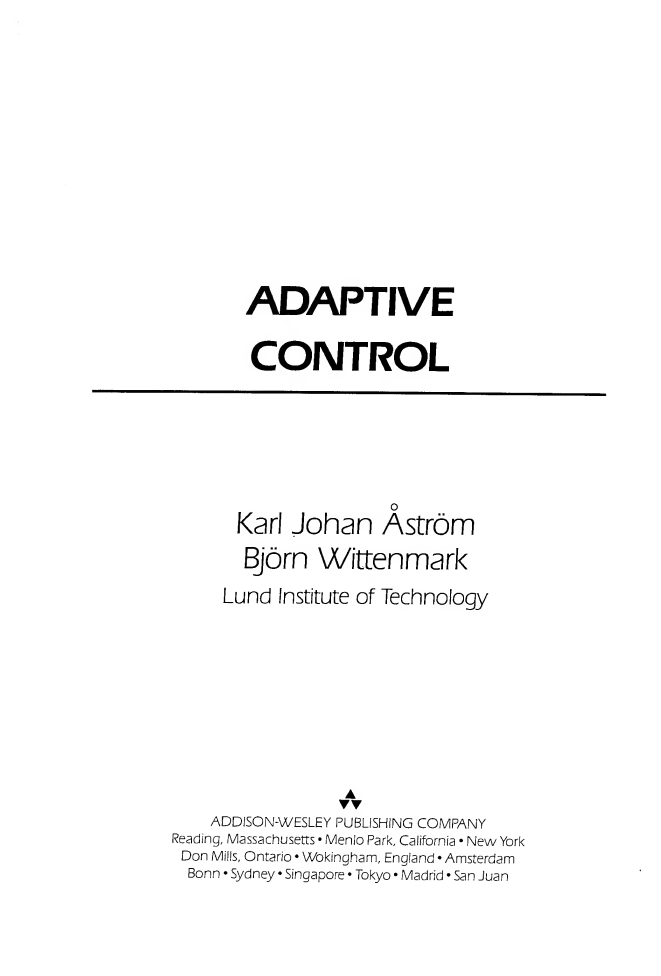
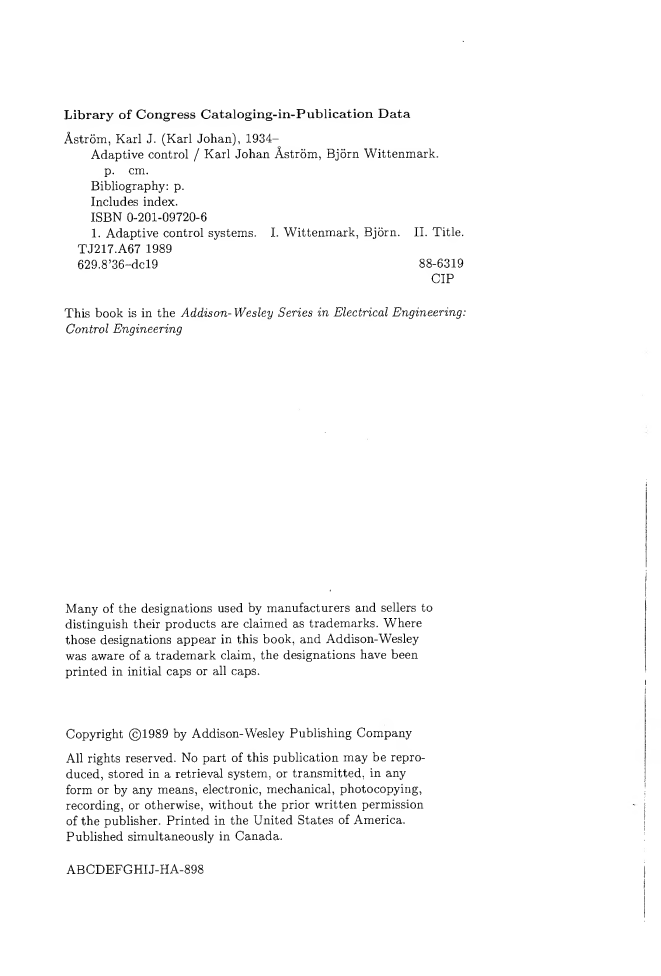
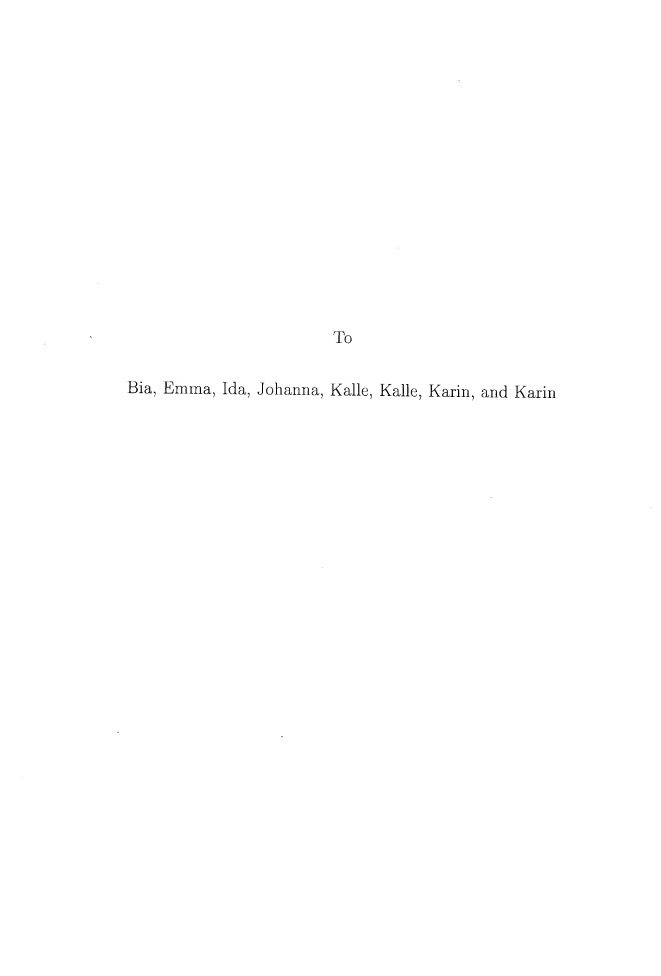
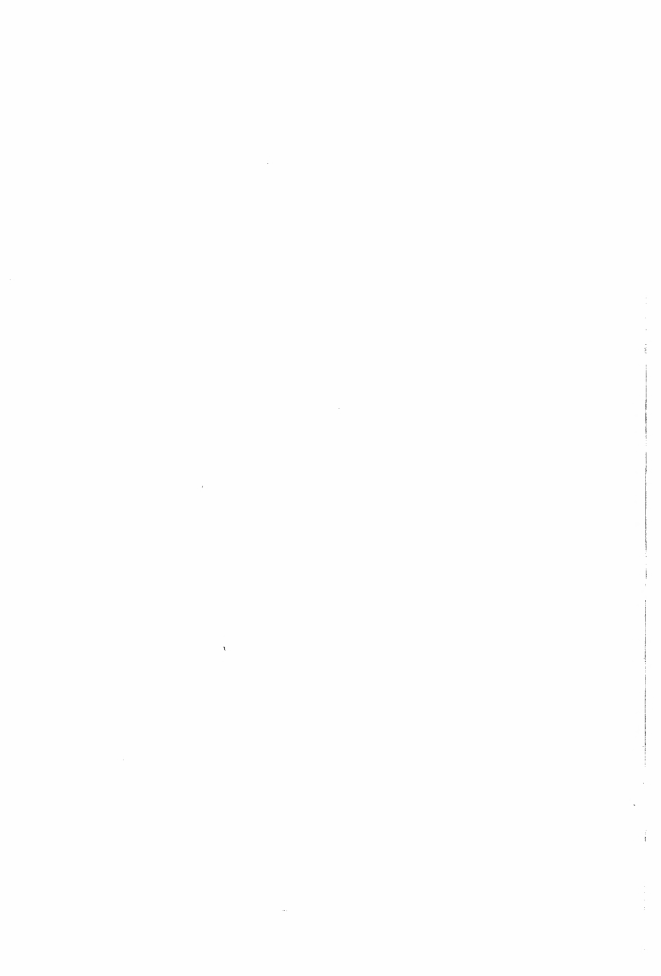
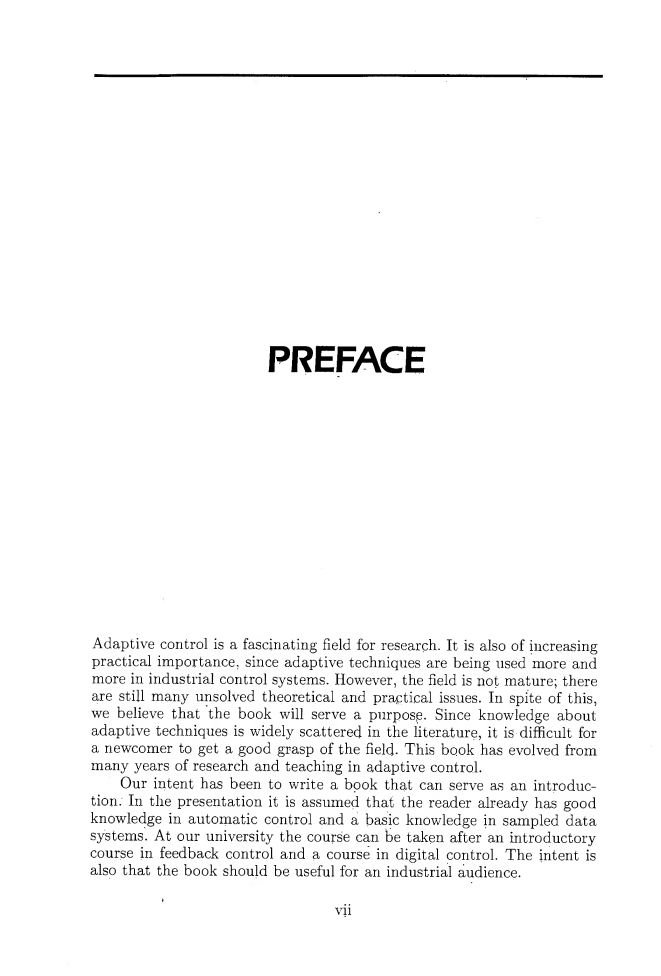
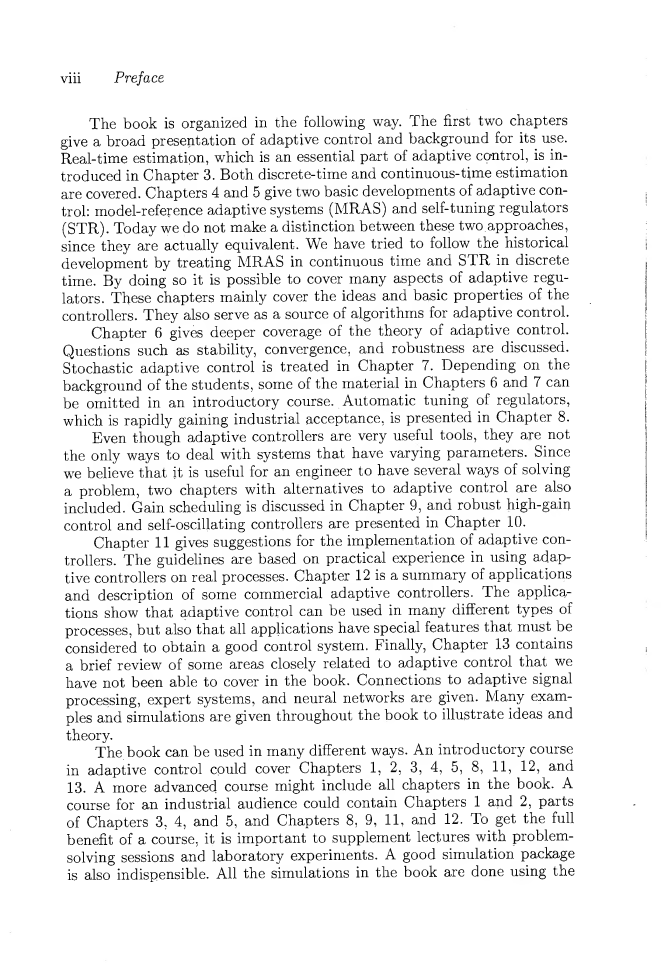
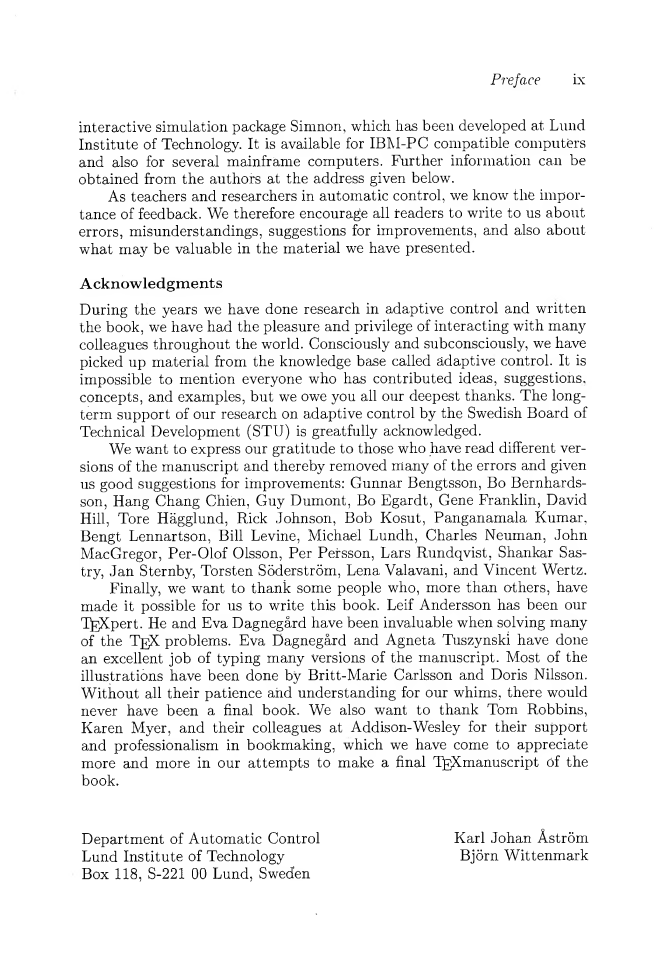
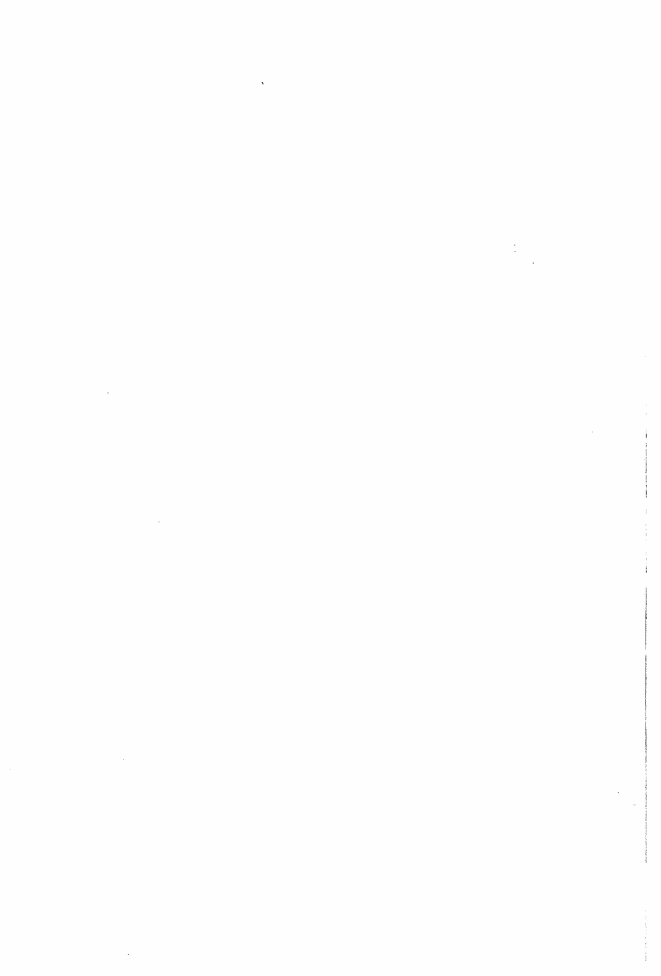








 2023年江西萍乡中考道德与法治真题及答案.doc
2023年江西萍乡中考道德与法治真题及答案.doc 2012年重庆南川中考生物真题及答案.doc
2012年重庆南川中考生物真题及答案.doc 2013年江西师范大学地理学综合及文艺理论基础考研真题.doc
2013年江西师范大学地理学综合及文艺理论基础考研真题.doc 2020年四川甘孜小升初语文真题及答案I卷.doc
2020年四川甘孜小升初语文真题及答案I卷.doc 2020年注册岩土工程师专业基础考试真题及答案.doc
2020年注册岩土工程师专业基础考试真题及答案.doc 2023-2024学年福建省厦门市九年级上学期数学月考试题及答案.doc
2023-2024学年福建省厦门市九年级上学期数学月考试题及答案.doc 2021-2022学年辽宁省沈阳市大东区九年级上学期语文期末试题及答案.doc
2021-2022学年辽宁省沈阳市大东区九年级上学期语文期末试题及答案.doc 2022-2023学年北京东城区初三第一学期物理期末试卷及答案.doc
2022-2023学年北京东城区初三第一学期物理期末试卷及答案.doc 2018上半年江西教师资格初中地理学科知识与教学能力真题及答案.doc
2018上半年江西教师资格初中地理学科知识与教学能力真题及答案.doc 2012年河北国家公务员申论考试真题及答案-省级.doc
2012年河北国家公务员申论考试真题及答案-省级.doc 2020-2021学年江苏省扬州市江都区邵樊片九年级上学期数学第一次质量检测试题及答案.doc
2020-2021学年江苏省扬州市江都区邵樊片九年级上学期数学第一次质量检测试题及答案.doc 2022下半年黑龙江教师资格证中学综合素质真题及答案.doc
2022下半年黑龙江教师资格证中学综合素质真题及答案.doc